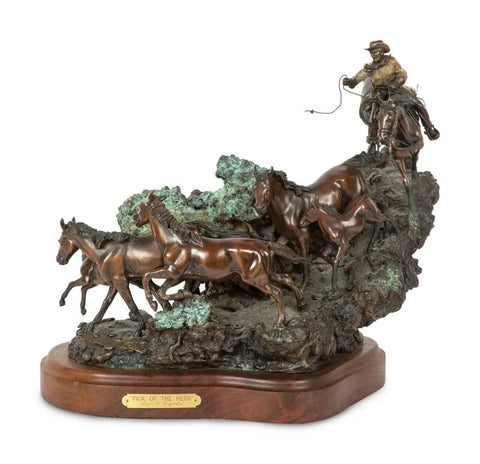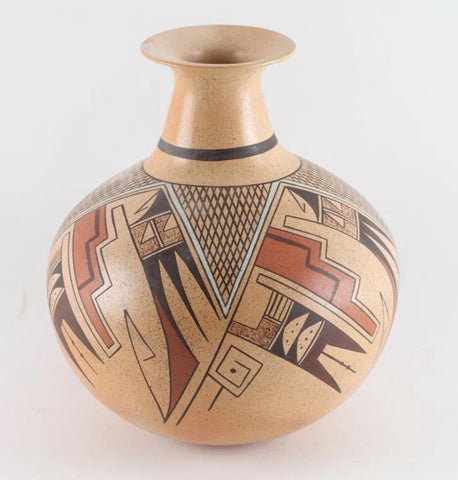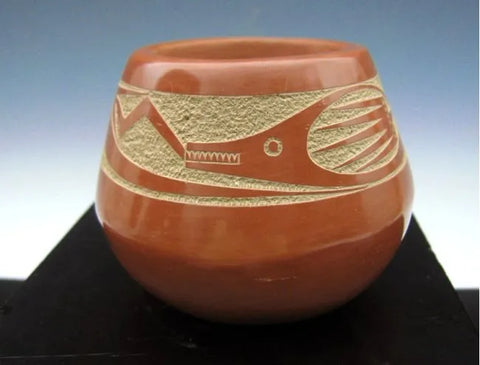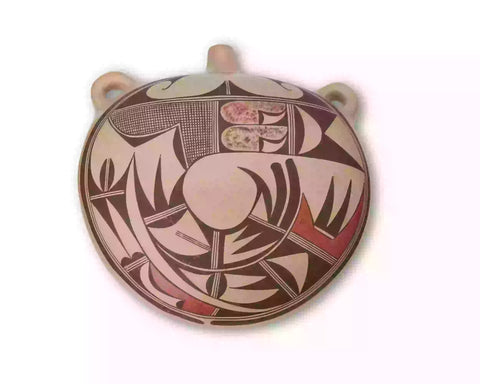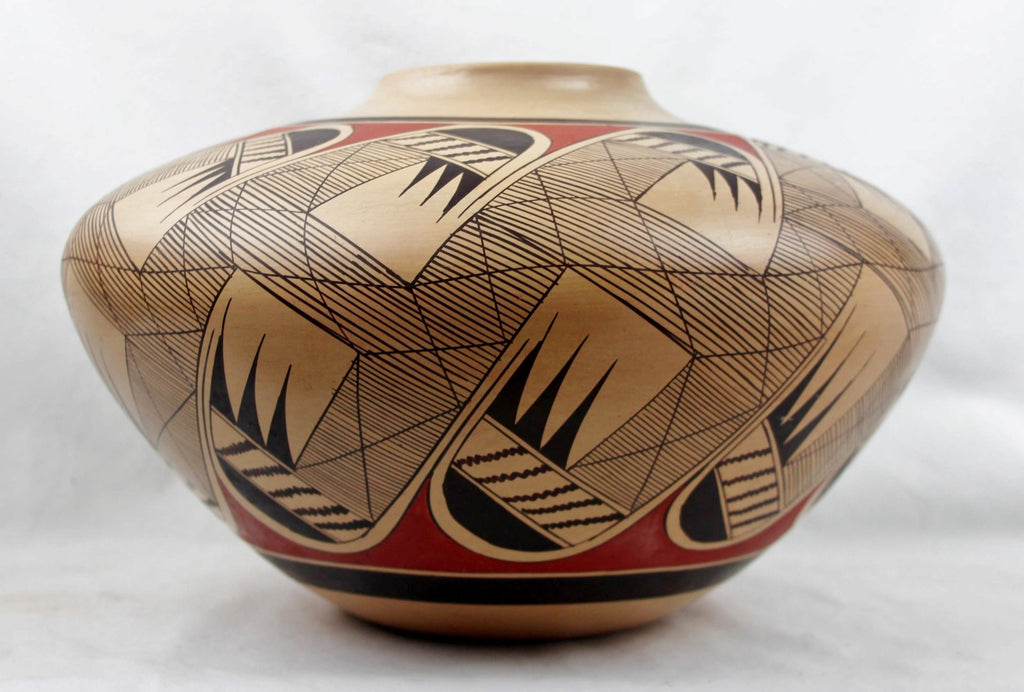
Native Amerian Vintage Hopi Poly Chrome Pottery Jar, by Clinton Polacca Nampeyo, Ca 1900's, #1497 SOLD
$ 3,600.00
Native American Vintage Hopi Poly Chrome Pottery Jar, by Clinton Polacca Nampeyo, Ca 1900's, #1497
Description: #1497 Native American, Vintage Hopi Poly Chrome Pottery Jar, by Clinton Polacca Nampeyo, Ca 1990's. Large, outstanding, traditional, poly chrome-on-yellow seed jar with avian inspired, Nampeyo "migration" design. Late 1900's
Condition: Very good condition.
Dimensions: 7.5" x 12"
Clinton Polacca Nampeyo (1958- ): Clinton Polacca Nampeyo of Hopi Pueblo. Clinton Nampeyo | Hopi Pueblo | Southwest Indian Pottery | Contemporary, Clinton Polacca Nampeyo, Hopi/Tewa, Kachina Clan, active 1975-present: Black and red on yellow jars. Clinton is the Great-grandson of Nampeyo; grandson of Fannie Polacca Nampeyo, and the son of Harold Polacca and his wife Alice, who was from the Akimel O'odham (Pima) tribe of Arizona. Clinton started potting around 1975 and had been taught by his grandmother, Fannie Nampeyo. "I learned from watching my grandmother, Fannie. I just starting doing pots by myself four years ago. I used to just make them, and she'd paint them. I have a respect for the designs. I usually just sell to people who really want them and connect with the design and respect it." - Clinton Polacca (Dillingham 1994). "I am not familiar with his pottery as this is the only one of his we have ever had in the gallery. If this jar is any indication of his workmanship, then I must say he is a very accomplished potter." -Al Anthony Jr. Credits: Text Reference: Hopi-Tewa Pottery: 500 Artist Biographies by Gregory Schaaf. (Source: Adobe Gallery)
“Pueblo pottery is made using a coiled technique that came into northern Arizona and New Mexico from the south, some 1500 years ago. In the four-corners region of the US, nineteen pueblos and villages have historically produced pottery. Although each of these pueblos use similar traditional methods of coiling, shaping, finishing and firing, the pottery from each is distinctive. Various clay's gathered from each pueblo’s local sources produce pottery colors that range from buff to earthy yellows, oranges, and reds, as well as black. Fired pots are sometimes left plain and other times decorated—most frequently with paint and occasionally with applique. Painted designs vary from pueblo to pueblo, yet share an ancient iconography based on abstract representations of clouds, rain, feathers, birds, plants, animals and other natural world features.
Tempering materials and paints, also from natural sources, contribute further to the distinctiveness of each pueblo’s pottery. Some paints are derived from plants, others from minerals. Before firing, potters in some pueblos apply a light colored slip to their pottery, which creates a bright background for painted designs or simply a lighter color plain ware vessel. Designs are painted on before firing, traditionally with a brush fashioned from yucca fiber.
Different combinations of paint color, clay color, and slips are characteristic of different pueblos. Among them are black on cream, black on buff, black on red, dark brown and dark red on white (as found in Zuni pottery), matte red on red, and poly chrome—a number of natural colors on one vessel (most typically associated with Hopi). Pueblo potters also produce un-decorated polished black ware, black on black ware, and carved red and carved black wares.
Making pueblo pottery is a time-consuming effort that includes gathering and preparing the clay, building and shaping the coiled pot, gathering plants to make the colored dyes, constructing yucca brushes, and, often, making a clay slip. While some Pueblo artists fire in kilns, most still fire in the traditional way in an outside fire pit, covering their vessels with large potsherds and dried sheep dung. Pottery is left to bake for many hours, producing a high-fired result.
Today, Pueblo potters continue to honor this centuries-old tradition of hand-coiled pottery production, yet value the need for contemporary artistic expression as well. They continue to improve their style, methods and designs, often combining traditional and contemporary techniques to create striking new works of art.” (Source: Museum of Northern Arizona)
Description: #1497 Native American, Vintage Hopi Poly Chrome Pottery Jar, by Clinton Polacca Nampeyo, Ca 1990's. Large, outstanding, traditional, poly chrome-on-yellow seed jar with avian inspired, Nampeyo "migration" design. Late 1900's
Condition: Very good condition.
Dimensions: 7.5" x 12"
Clinton Polacca Nampeyo (1958- ): Clinton Polacca Nampeyo of Hopi Pueblo. Clinton Nampeyo | Hopi Pueblo | Southwest Indian Pottery | Contemporary, Clinton Polacca Nampeyo, Hopi/Tewa, Kachina Clan, active 1975-present: Black and red on yellow jars. Clinton is the Great-grandson of Nampeyo; grandson of Fannie Polacca Nampeyo, and the son of Harold Polacca and his wife Alice, who was from the Akimel O'odham (Pima) tribe of Arizona. Clinton started potting around 1975 and had been taught by his grandmother, Fannie Nampeyo. "I learned from watching my grandmother, Fannie. I just starting doing pots by myself four years ago. I used to just make them, and she'd paint them. I have a respect for the designs. I usually just sell to people who really want them and connect with the design and respect it." - Clinton Polacca (Dillingham 1994). "I am not familiar with his pottery as this is the only one of his we have ever had in the gallery. If this jar is any indication of his workmanship, then I must say he is a very accomplished potter." -Al Anthony Jr. Credits: Text Reference: Hopi-Tewa Pottery: 500 Artist Biographies by Gregory Schaaf. (Source: Adobe Gallery)
“Pueblo pottery is made using a coiled technique that came into northern Arizona and New Mexico from the south, some 1500 years ago. In the four-corners region of the US, nineteen pueblos and villages have historically produced pottery. Although each of these pueblos use similar traditional methods of coiling, shaping, finishing and firing, the pottery from each is distinctive. Various clay's gathered from each pueblo’s local sources produce pottery colors that range from buff to earthy yellows, oranges, and reds, as well as black. Fired pots are sometimes left plain and other times decorated—most frequently with paint and occasionally with applique. Painted designs vary from pueblo to pueblo, yet share an ancient iconography based on abstract representations of clouds, rain, feathers, birds, plants, animals and other natural world features.
Tempering materials and paints, also from natural sources, contribute further to the distinctiveness of each pueblo’s pottery. Some paints are derived from plants, others from minerals. Before firing, potters in some pueblos apply a light colored slip to their pottery, which creates a bright background for painted designs or simply a lighter color plain ware vessel. Designs are painted on before firing, traditionally with a brush fashioned from yucca fiber.
Different combinations of paint color, clay color, and slips are characteristic of different pueblos. Among them are black on cream, black on buff, black on red, dark brown and dark red on white (as found in Zuni pottery), matte red on red, and poly chrome—a number of natural colors on one vessel (most typically associated with Hopi). Pueblo potters also produce un-decorated polished black ware, black on black ware, and carved red and carved black wares.
Making pueblo pottery is a time-consuming effort that includes gathering and preparing the clay, building and shaping the coiled pot, gathering plants to make the colored dyes, constructing yucca brushes, and, often, making a clay slip. While some Pueblo artists fire in kilns, most still fire in the traditional way in an outside fire pit, covering their vessels with large potsherds and dried sheep dung. Pottery is left to bake for many hours, producing a high-fired result.
Today, Pueblo potters continue to honor this centuries-old tradition of hand-coiled pottery production, yet value the need for contemporary artistic expression as well. They continue to improve their style, methods and designs, often combining traditional and contemporary techniques to create striking new works of art.” (Source: Museum of Northern Arizona)
Related Products
Sold out
Sold out








